|
ARMAGEDDON AND PROPHECIES OF THE RETURN
-
Will they return?
-
When will they return?
These questions have been asked of me countless times, “they” being
the Anunnaki gods whose saga has filled my books.
The answer to the
first question is yes; there are clues that need to be heeded, and
the prophecies of the Return need to be fulfilled. The answer to the
second question has preoccupied Mankind ever since the watershed
events in Jerusalem more than two thousand years ago.
But the question is not only “if” and “when.”
What will the Return
signal, what will it bring with it? Will it be a benevolent coming,
or—as when the Deluge was looming— bring about the End? Which
prophecies would come true: a Messianic Time, the Second Coming, a
new Beginning— or perhaps a catastrophic Apocalypse, the Ultimate
End, Armageddon...
It is the last possibility that shifts these prophecies from the
realm of theology, escatology, or mere curiosity to a matter of
Mankind’s very survival; for Armageddon, a term that has come to
denote a war of unimagined calamitous scope, is in fact the name of
a specific place in a land that has been subjected to threats of
nuclear annihilation.
In the twenty-first century b.c.e., a war of the Kings of the East
against the Kings of the West was followed by
a nuclear calamity.
Twenty-one centuries later, when b.c.e. changed to a.d., Mankind’s
fears were expressed in a scroll, hidden in a cave near the Dead
Sea, that described a great and final “War of the Sons of Light
Against the Sons of Darkness.”
Now again, in the twenty-first century a.d., a nuclear threat hangs
over the very same historical place. It is enough reason to ask:
Will history repeat itself—does history repeat itself, in some
mysterious way, every twenty-one centuries?
A war, an annihilating conflagration, has been depicted as part of
the End of Days scenario in Ezekiel (chapters 38–39). Though “Gog of
the land of Magog,” or “Gog and Magog,” are foreseen as the
principal instigators in that final war, the list of combatants that
shall be sucked into the battles encompassed virtually every nation
of note; and the focus of the conflagration shall be “the dwellers
of the Navel of the Earth”—the people of Jerusalem according to the
Bible, but the people of “Babylon” as a replacement for Nippur to
those for whom the clock stopped there.
It is a spine-chilling realization that Ezekiel’s list of those
widespread nations (38: 5) that will engage in the final
war—Armageddon—actually begins with PERSIA— the very country
(today’s Iran) whose leaders seek nuclear weapons with which to
“wipe off the face of the Earth” the people who dwell where Har-Megiddo is!
Who is that “Gog of the land of Magog,” and why does that prophecy
from two and a half millennia ago sound so much like current
headlines? Does the accuracy of such details in the Prophecy point
to the When—to our time, to our century?
Armageddon, a Final War of Gog and Magog, is also an essential
element of the End of Days scenario of the New Testament’s prophetic
book, Revelation (whose full name is The Apocalypse of St. John the
Divine). It compares the instigators of the apocryphal events to two
beasts, one of which can “make fire come down from heaven to earth,
in sight of men.”
Only an enigmatic clue is given for its identity
(13: 18):
Here is wisdom:
Let him that hath understanding
count the number of the beast:
It is the number of a man; and his number is
six hundred and threescore and six.
Many have attempted to decipher the mysterious number 666, assuming
it is a coded message pertaining to the End of Days.
Because the
book was written when the persecution of Christians in Rome began,
the accepted interpretation is that the number was a code for the
oppressor emperor Nero, the numerical value of whose name in Hebrew
(NeRON QeSaR) added up to 666. The fact that he had been to the
space platform in
Baalbek, possibly to inaugurate the temple to
Jupiter there, in the year a.d. 60 may—or may not—have a bearing on
the 666 puzzle.
That there could be more to 666 than a connection to Nero is
suggested by the intriguing fact that 600, 60, and 6 are all basic
numbers of the Sumerian sexagesimal system, so that the “code” might
hark back to some earlier texts; there were 600 Anunnaki, Anu’s
numerical rank was 60, Ishkur/Adad’s rank was 6.
Then, if the three
numbers are to be multiplied rather than added, we get 666 = 600 ×
60 × 6 = 216,000, which is the familiar 2160 (a zodiacal age) times
100—a result that can be speculated on endlessly.
Then there is the puzzle that when seven angels reveal the sequence
of future events, they do not link them to Rome; they link them to
“Babylon.” The conventional explanation has been that, like the 666
was a code for the Roman ruler, so was “Babylon” a code word for
Rome.
But Babylon was already gone for centuries when Revelation was
written, and Revelation, speaking of Babylon, unmistakably links the
prophecies to “the great river Euphrates” (9: 14), even describing
how “the sixth angel poured out his vial upon the great river
Euphrates,” drying it up so that the Kings of the East would be
joined in the fighting (16: 12). The talk is of a city/land on the
Euphrates, not on the Tiber River.
Since Revelation’s prophecies are of the future, one must conclude
that “Babylon” is not a code—Babylon means Babylon, a future Babylon
that will get involved in the war of “Armageddon” (which verse 16:
16 correctly explains as the name of “a place in the Hebrew
tongue”—Har-Megiddo, Mount Megiddo, in Israel)—a war involving the
Holy Land.
If that future Babylon is indeed today’s Iraq, the prophetic verses
are again chilling, for as they foretell current events leading to
the fall of Babylon after a brief but awesome war, they predict the
breakup of Babylon/Iraq into three parts!
(16: 19).
Like the Book of Daniel, which predicted phases of tribulations and
trying stages in the messianic process, so has Revelation tried to
explain the enigmatic Old Testament prophecies by describing
(Chapter 20) a First Messianic Age with “a First Resurrection”
lasting a thousand years, followed by a Satanic reign of a thousand
years (when “Gog and Magog” will engage in an immense war), and then
a second messianic time and another resurrection (and thus the
“Second Coming”).
Unavoidably, these prophecies triggered a frenzy of speculation as
the year a.d. 2000 approached: speculation regarding the Millennium
as a point in time, in the history of Mankind and the Earth, when
prophecies would come true.
Besieged with millennium questions as the year 2000 neared, I told
my audiences that nothing will happen in 2000, and not only because
the true millennium point counting from the birth of Jesus had
already passed, Jesus having been born, by all scholarly
calculations, in 6 or 7 b.c.e.
The main reason for my opinion was
that the prophecies appeared to envision not a linear timeline—year
one, year two, year nine hundred, and so on—but a cyclical
repetition of events, the fundamental belief that “The First Things
shall be the Last Things”—something that can happen only when
history and historical time move in a circle, where the start point
is the end point, and vice versa.
Inherent in this cyclical plan of history is the concept of God as
an everlasting divine entity who had been present at the Beginning
when Heaven and Earth were created and who will be there at the End
of Days, when his kingdom shall be renewed upon his holy mount.
It
is expressed in repeated statements from the earliest biblical
assertions through the latest Prophets, as when God announced,
through Isaiah (41: 4, 44: 6, 48: 12):
I am He, I am the First and also the Last I am . . .
From the Beginnings the Ending I foretell,
and from ancient times the things that are not
yet done.
Isaiah 48: 12, 46: 10
And equally so (twice) in the New Testament’s Book of Revelation:
I am Alpha and Omega,
the Beginning and the Ending,
sayeth the Lord—
Which is, and which was, and which will be.
Revelation 1: 8
Indeed, the basis for prophecy was the belief that the End was
anchored in the Beginning, that the Future could be predicted
because the Past was known—if not to Man, then to God: I am the one
“who from the Beginning tells the End,” Yahweh said (Isaiah 46: 10).
The Prophet Zechariah (1: 4, 7: 7, 7: 12) foresaw God’s plans for
the future—the Last Days— in terms of the Past, the First Days.
This belief, which is restated in the Psalms, in Proverbs, and in
the Book of Job, was viewed as a universal divine plan for the whole
Earth and all its nations.
The Prophet Isaiah, envisioning the
Earth’s nations gathered to find out what is in store, described
them asking each other:
“Who among us can tell the future by letting
us hear the First Things?”
(41: 22)
That this was a universal tenet
is shown in a collection of Assyrian Prophecies, when the god Nabu
told the Assyrian king Esarhaddon: “The future shall be like the
past.”
This cyclical element of the biblical Prophecies of the Return leads
us to one current answer to the question of WHEN.
A cyclical revolving of historical time was found, the reader will
recall, in Mesoamerica, resulting from the meshing, like the gears
of wheels, of two calendars (see Fig. 67), creating the “bundle” of
52 years, on the occurring of which—after an unspecified number of
turns—Quetzalcoatl (alias
Thoth/Ningishzidda) promised to return.
And that introduces us to the so-called Mayan Prophecies, according
to which the End of Days will come about in a.d.
2012.
The prospect that the prophesied crucial date is almost at hand has
naturally attracted much interest, and merits explaining and
analyzing. The claimed date arises from the fact that in that year
(depending how one calculates) the time unit called Baktun will
complete its thirteenth turn.
Since a Baktun lasts 144,000 days, it
is some kind of a milestone.
Some errors, or fallacious assumptions, in this scenario need to be
pointed out. The first is that the Baktun belongs not to the two
“meshing” calendars with the 52-year promise (the Haab and the
Tzolkin), but to a third and much older calendar called The Long
Count. It was introduced by
the Olmecs—Africans who had come to
Mesoamerica when Thoth was exiled from Egypt—and the count of days
actually began with that event, so that Day One of the Long Count
was in what we date as August 3113 b.c.e.
Glyphs in that calendar
represented the following sequence of units:
1 kin = 1 day
1 Uinal = 1 kin × 20 = 20 days
1 Tun = 1 kin × 360 = 360 days
1 Ka-tun = 1 tun × 20 = 7,200 days
1 Bak-tun = 1 Ka-tun × 20 = 144,000 days
1 Pictun = 1 Bak-tun × 20 = 2,880,000 days
These units, each a multiple of the previous one, thus continued
beyond the Baktun with ever-increasing glyphs.
But since Mayan
monuments never reached beyond 12 Baktuns, whose 1,728,000 days were
already beyond the Mayan existence, the 13th Baktun appears as a
real milestone. Besides, Mayan lore purportedly held that the
present “Sun” or Age would end with the 13th Baktun, so when its
number of days (144,000 × 13 = 1,872,000) is divided by 365.25, it
results in the passage of 5,125 years; when the b.c.e. 3113 is
deducted,
the result is the year a.d. 2012.
This is an exciting as well as an ominous prediction.
But that date
has been challenged, already a century ago, by scholars (like Fritz
Buck,
El Calendario Maya en la Cultura de Tiahuanacu) who pointed
out that as the above list indicates, the multiplier, and thus the
divider, should be the calendar’s own mathematically perfect 360 and
not 365.25.
That way, the 1,872,000 days result in 5,200 years—a
perfect result, because it represents exactly 100 “bundles” of
Thoth’s magical number 52. Thus calculated, Thoth’s magical year of
the Return would be a.d. 2087 (5200 - 3113 = 2087).
One could stand even that wait; the only fly in the ointment is that
the Long Count is a linear time count, and not the required cyclical
one, so that its counted days could roll on to the fourteenth Baktun
and the fifteenth Baktun and on and on.
All that, however, does not eliminate the significance of a
prophetic millennium. Since the source of “millennium” as an
escatological time had its origins in Jewish apocryphal writings
from the 2nd century b.c.e., the search for meaning must shift in
that direction.
In fact, the reference to “a thousand”—a
millennium—as defining an era had its roots way back in the Old
Testament. Deuteronomy (7: 9) assigned to the duration of God’s
covenant with Israel a period of “a thousand generations”—an
assertion repeated (I Chronicles 16:15) when the Ark of the Covenant
was brought to Jerusalem by David.
The Psalms repeatedly applied the
number “thousand” to Yahweh, his wonders, and even to his chariot
(Psalm 68: 17).
Directly relevant to the issue of the End of Days and the Return is
the statement in Psalm 90: 4—a statement attributed to Moses
himself—that said of God that “a thousand years, in thy eyes, are
but as one day that has passed.” This statement has given rise to
speculation (which started soon after the Roman destruction of the
Temple) that it was a way to figure out the elusive messianic End of
Days: if Creation, “The Beginning,” according to Genesis, took God
six days, and a divine day lasts a thousand years, the result is a
duration of 6,000 years from Beginning to End.
The End of Days, it
has thus been figured, will come in the Anno Mundi year 6,000.
Applied to the Hebrew calendar of Nippur that began in 3760 b.c.e.,
this means that the End of Days will occur in
a.d. 2240 (6000 - 3760 = 2240).
This third End of Days calculation may be disappointing or
comforting—it depends on one’s expectations. The beauty of this
calculation is that it is in perfect harmony with the Sumerian sexagesimal (“base 60”) system. It might even prove in future to be
correct, but I don’t think so: it is again linear—and it is a
cyclical time unit that is called for by the prophecies.
With none of the “modern” predicted dates workable, one must look
back at the olden “formulas”—do what had been advised in Isaiah,
“look at the signs backwards.” We have two cyclical choices: the
Divine Time orbital period of Nibiru, and the Celestial Time of the
zodiacal Precession. Which one is it?
That the Anunnaki came and went during a “window of opportunity”
when Nibiru arrived at Perigee (nearest the Sun, and thus the
closest to Earth and Mars) is so obvious that some readers of mine
used to simply deduct 3600 from 4000 (as a round date for Anu’s last
visit), resulting in 400 b.c.e., or deduct 3,600 from 3760 (when the
Nippur calendar began)— as the Maccabees did—and arrive at 160
b.c.e. Either way, the next arrival of Nibiru is way in the distant
future.
In fact, as the reader now knows, Nibiru arrived earlier, circa 560
b.c.e.
When considering that “digression,” one must keep in mind
that the perfect SAR (3600) has always been a mathematical orbital
period, because celestial orbits—of planets, comets,
asteroids—digress from orbit to orbit due to the gravitational tug
of other planets near which they pass. To use the well-tracked
Halley’s Comet as an example, its given period of 75 years actually
fluctuates from 74 to 76; when it last appeared in 1986, it was 76
years. Extend Halley’s digression to Nibiru’s 3600, and you get a
plus/ minus variant of about 50 years each way.
There is one other reason for wondering why Nibiru had digressed so
much from its wonted SAR: the unusual occurrence of the Deluge circa
10900 b.c.e.
During its 120 SARs before the Deluge, Nibiru orbited without
causing such a catastrophe. Then something unusual happened that
brought Nibiru closer to Earth: combined with the slippage
conditions of the ice sheet covering Antarctica, the Deluge
occurred.
What was that “something unusual”?
The answer may well lie farther out in our solar system, where
Uranus and Neptune orbit—planets whose many moons include some that,
inexplicably, orbit in an “opposite” (“retrograde”) direction—the
way Nibiru orbits.
One of the great mysteries in our solar system is the fact that the
planet Uranus literally lies on its side—its north-south axis faces
the Sun horizontally instead of being vertical to it. “Something”
gave Uranus a “big whack” sometime in its past, NASA’s scientists
said—without venturing to guess what the “something” was.
I have
often wondered whether that “something” was also what caused the
huge mysterious “chevron” scar and an unexplained “ploughed” feature
that NASA’s Voyager 2 found on
Uranus’s moon Miranda in 1986 (Fig.
128)—a moon that is different in numerous ways from
the other moons of Uranus.
Could a celestial collision with a
passing Nibiru and its moons cause all that?
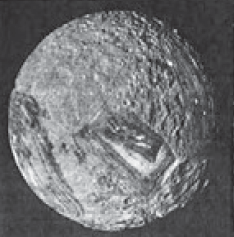
Figure 128
In recent years astronomers have ascertained that the outer large
planets have not stayed put where they were formed, but have been
drifting outward, away from the Sun.
The studies concluded that the
shift has been most pronounced in the case of Uranus and Neptune
(see sketch, Fig. 129), and that can explain why nothing happened
out there for many Nibiru orbits—then suddenly something did. It is
not implausible to assume that on its “Deluge” orbit Nibiru
encountered the drifting Uranus, and one of Nibiru’s moons struck
Uranus, tilting it on its side; it could even be that the strike
“weapon” was the enigmatic moon Miranda—a moon of Nibiru—striking
Uranus and ending up captured to orbit Uranus.
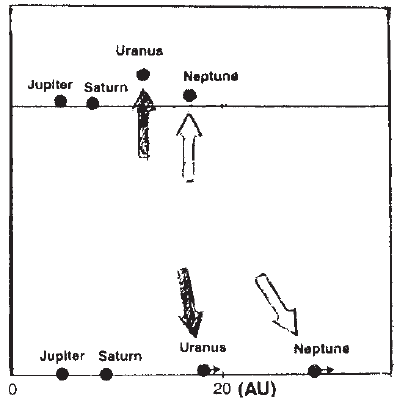
Figure 129
Such an occurrence
would have affected the orbit of Nibiru, slowing it down to about
3450 Earth-years rather than 3600, and resulting in a post-Diluvial
reappearance schedule of circa 7450, circa 4000, and circa 550
b.c.e.
If that is what had happened, it would explain the “early” arrival of
Nibiru in 556 b.c.e.—and suggest that its next arrival will be circa
a.d. 2900. For those who associate the prophesied cataclysmic events
with the return of Nibiru— “Planet X” to some—the time is not at
hand.
But any notion that the Anunnaki limited their comings and goings to
a single short “window” at the planet’s perigee is, however,
incorrect. They could keep coming and going at other times as well.
The ancient texts record numerous instances of back-and-forth travel
by the gods with no indication of a link to the planet’s proximity.
There are also a number of tales of Earth-Nibiru travel by
Earthlings that omit any assertion of Nibiru seen in the skies (a
sight stressed, on the other hand, when Anu visited Earth circa 4000
b.c.e.).
In one instance Adapa, a son of Enki by an Earthling woman,
who was given Wisdom but not immortality, paid a very short visit to
Nibiru, accompanied by the gods Dumuzi and Ningishzidda. Enoch,
emulating the Sumerian Enmeduranki, also came and went, twice, in
his lifetime on Earth.
This was possible in at least two ways, as shown in Fig. 130: one by
a spaceship accelerating on Nibiru’s incoming phase (from point A),
arriving well ahead of perigee time; the other by decelerating a
spacecraft (at point B) during Nibiru’s outbound phase, “falling
back” toward the Sun (and thus to Earth and Mars).
A short visit to
Earth, like the one by Anu, could take place by combining “A” for
arrival and “B” for outbound departure; a short visit to Nibiru (as
by Adapa) could take place by reversing the procedure—by leaving
Earth to intercept Nibiru at “A” and departing from Nibiru at “B”
for the return to earth, and so on.
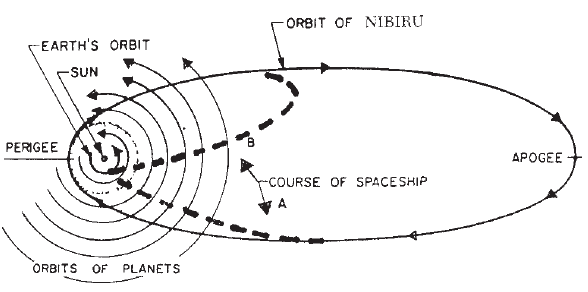
Figure 130
A Return of the Anunnaki at a time other than the planet’s return
can thus take place, and for that we are left with the other
cyclical time—zodiacal time.
I have called it, in
When Time Began, Celestial Time, distinct from
yet serving as a link between Earthly Time (our planet’s orbital
cycle) and Divine Time (the clock of the Anunnaki’s planet).
If the
expected Return will be of the Anunnaki rather than of their planet,
then it behooves us to seek the solution to the enigmas of gods and
men through the clock that has linked them—the cyclical zodiac of
Celestial Time. It was invented, after all, by the Anunnaki as a way
to reconcile the two cycles; their ratio—3600 for Nibiru, 2l60 for a
zodiacal Age—was the Golden Ratio of 10:6.
It resulted, I have
suggested, in the sexagesimal system on which Sumerian mathematics
and astronomy were based (6 × 10 × 6 × 10 and so on).
Berossus, as we have mentioned, deemed the zodiacal Ages to be
turning points in the affairs of gods and men and held that the
world periodically undergoes apocalyptic catastrophes, either by
water or by fire, whose timing is determined by heavenly phenomena.
Like his counterpart Manetho in Egypt, he also divided prehistory
and history into divine, semidivine, and postdivine phases, with a
grand total of 2,160,000 years of “the duration of this world.”
This—wonder of wonders!—is exactly one thousand—a
millennium!—zodiacal ages.
Scholars studying ancient clay tablets dealing with mathematics and
astronomy were astounded to discover that the tablets used the
fantastic number 12960000—yes, 12,960,000—as a starting point.
They
concluded that this could only be related to the zodiacal ages of
2,160, whose multiples result in 12,960 (if 2,160 × 6), or 129,600
(if 2,160 × 60), or 1,296,000 (if multiplied by 600); and—wonder of
wonders!—the fantastic number with which these ancient lists begin,
12,960,000, is a multiple of 2,160 by 6,000—as in the divine six
days of creation.
That major events, when the affairs of the gods affected the affairs
of men, were linked to zodiacal ages has been shown throughout this
volume of The Earth Chronicles. As each Age began, something
momentous took place: the Age of Taurus signaled the grant of
civilization to Mankind. The Age of Aries was ushered in by the
nuclear upheaval and ended with the Departure.
The Age of Pisces
arrived with the destruction of the Temple and the beginning of
Christianity.
-
Should one not wonder whether the prophetic End of
Days really means End of (zodiacal) Age?
-
Were the “time, times, and a half ” of Daniel simply a terminology
referring to zodiacal ages?
The possibility was pondered, some three
centuries ago, by none other than Sir Isaac Newton.
Best known for
his formulation of the natural laws governing celestial motions—such
as planets orbiting the Sun—his interests also lay in religious
thought, and he wrote lengthy treatises about the Bible and biblical
prophecies. He considered the celestial motions that he formulated
to be “the mechanics of God,” and he strongly believed that the
scientific discoveries that began with Galileo and Copernicus and
were continued by him were meant to happen when they did. This led
him to pay particular attention to the “mathematics of Daniel.”
In March 2003 the British Broadcasting Corporation (BBC) startled
the scientific and religious establishments with a program on Newton
that revealed the existence of a document, handwritten by him on
front and back, that calculated the End of Days according to
Daniel’s prophecies.
Newton wrote his numerical calculations on one side of the sheet,
and his analysis of the calculations as seven “propositions” on the
paper’s other side. A close examination of the document—a photocopy
of which I am privileged to have—reveals that the numbers that he
used in the calculations include 216 and 2160 several times—a clue
to me to understand what his line of thought was: he was thinking of
zodiacal time—to him, that was the Messianic Clock!
He summed up his conclusions by writing down a set of three “not
before” and a “not later than” timetable for Daniel’s prophetic
clues:
-
Between 2132 and 2370 according
to one clue given to Daniel
-
Between 2090 and 2374 according
to a second clue
-
Between 2060 and 2370 for the crucial “time, times & half time”
“Sir Isaac Newton predicted the world would end in the year 2060,”
the BBC announced.
Not exactly, perhaps— but as the table of
zodiacal ages in an earlier chapter shows, he was not far off the
mark in two of his “not earlier than” dates: 2060 and 2090.
The original cherished document of the great Englishman is now kept
in the Department of Manuscripts and Archives of the Jewish National
and University Library—in Jerusalem!
A coincidence?
It was in my 1990 book
Genesis Revisited that the “Phobos
Incident”—a hushed-up event—was first publicly revealed. It
concerned the loss, in 1989, of a Soviet spacecraft sent to explore
Mars and its possibly hollow moonlet called Phobos.
In fact, not one but two Soviet spacecraft were lost. Named Phobos 1
and Phobos 2 to indicate their purpose—to probe Mars’ moonlet
Phobos—they were launched in 1988, to reach Mars in 1989. Though a
Soviet project, it was supported by NASA and European agencies.
Phobos 1 just vanished—no details or explanation were ever publicly
given. Phobos 2 did make it to Mars, and started to send back
photographs taken by two cameras—a regular one and an infrared one.
Amazingly or alarmingly, they included pictures of the shadow of a
cigar-shaped object flying in the planet’s skies between the Soviet
craft and the surface of Mars (Fig. 131 by the two cameras). The
Soviet mission chiefs described the object that cast the shadow as
“something which some may call a flying saucer.”
Immediately, the
spacecraft was directed to shift from Mars orbit to approach the
moonlet and, from a distance of 50 yards, bombard it with laser
beams.
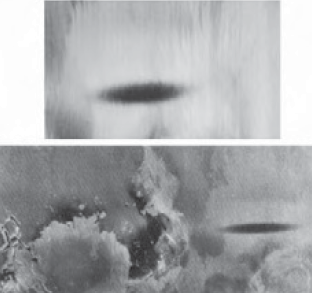
Figure 131
The last picture Phobos 2 sent showed a missile coming at it from
the moonlet (Fig. 132). Immediately after that, the spacecraft went
into a spin and stopped transmitting—destroyed by the mysterious
missile.
The “Phobos incident” remains, officially, an “unexplained
accident.” In fact, right thereafter, a secret commission on which
all the leading space nations were represented sprang into action.
The commission and the document it formulated merit more scrutiny
than they received, for they hold the key to understanding what the
world’s leading nations really know about
Nibiru and
the Anunnaki.
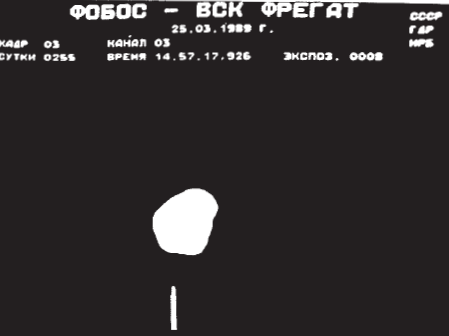
Figure 132
The geopolitical events that resulted in the secret group’s
formation began with the discovery, in 1983, of a “Neptunesized
planet” by IRAS—NASA’s Infra-Red Astronomical Satellite—which
scanned the edges of the solar system not visually but by detecting
heat-emitting celestial bodies.
The search for a tenth planet was
one of its stated objectives, and indeed it found one—determining
that it was a planet because, detected once and then again six
months later, it was clearly moving in our direction.
The news of the discovery
made headlines (Fig. 133) but was retracted the next day as a
“misunderstanding.”
In fact, the discovery was so shocking that it
led to a sudden change in U.S.–Soviet relations, a meeting and an
agreement for space cooperation between President Reagan and
Chairman Gorbachev, and
public statements by the President at the
United Nations and other forums that included the following words
(pointing heavenwards with his finger as he said them):
Just think how easy his task and mine might be in these meetings
that we held if suddenly there was a threat to this world from some
other species from another planet outside in the universe... I
occasionally think how quickly our differences would vanish if we
were facing an alien threat from outside this world.
The Working Committee that was formed as a result of these concerns
conducted several meetings and leisurely
consultation—until the March
1989 Phobos incident.
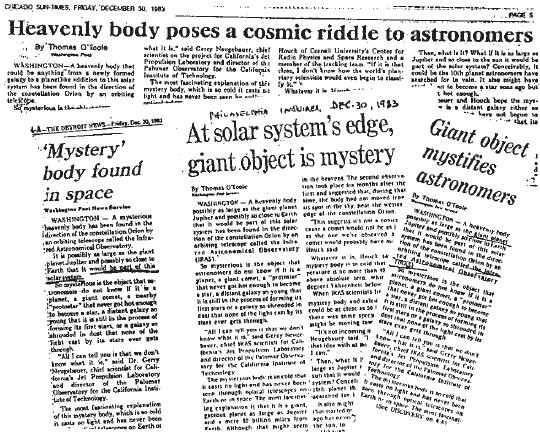
Figure 133
Working
feverishly, it formulated in April 1989 a set of guidelines known as
the Declaration of Principles Concerning Activities Following the
Detection of Extraterrestrial Intelligence,
by which the procedures to be followed after receiving “a signal or
other evidence of extraterrestrial intelligence”
were agreed upon.
The “signal,” the group revealed,
“might not be
simply one that indicates its intelligent origin but could be an
actual message that may need decoding.”
The agreed procedures
included undertakings to delay disclosure of the contact for at
least twenty-four hours before a response is made. This was surely
ridiculous if the message had come from a planet light years away... No, the preparations were for a nearby encounter!
To me, all these events since 1983, plus all the evidence from Mars
briefly described in previous chapters, and the missile shot out
from the moonlet Phobos, indicate that the Anunnaki still have a
presence—probably a robotic presence—on
Mars, their olden
Way
Station. That could indicate forethought, a plan to have a facility
ready for a future revisit. Put together, it suggests an intent for
a Return.
To me, the Earth-Mars cylinder seal (see Fig. 113) is both a
depiction of the Past and a foretelling of the Future because it
bears a date—a date indicated by the sign of two fishes— the Age of
Pisces.
Does it tell us: What had taken place in a previous Age of Pisces
will be repeated again in the Age of Pisces?
If the prophecies are
to come true, if the First Things shall be the Last Things, if the
Past is the Future—the answer has to be Yes.
We are still in the Age of Pisces.
The Return, the signs say, will
happen before the end of our current Age.
Back to Contents
|





